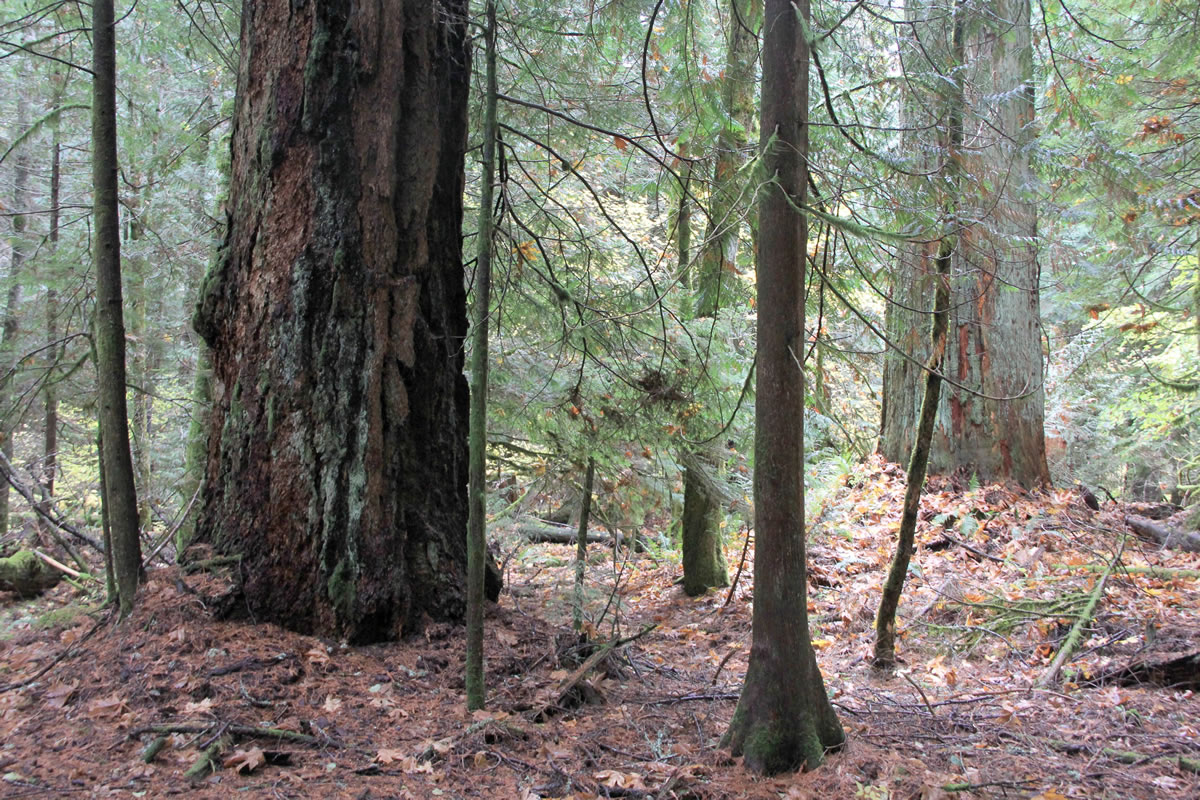WILLARD — To find the largest waterfalls in the Columbia River Gorge, all that’s required is a drive out Interstate 84 to the many viewpoints and trailheads east of Portland.
To find the largest trees in the Gorge, however, you’re in for a lot more work.
In an area with a long history of logging, precious few groves of old-growth trees remain intact. The ones that do remain are way off the beaten path, known only to a handful of big-tree hunters often reluctant to share the location.
Such is the case with what Hood River photographer Darryl Lloyd has dubbed the “Giant Trees of Lost Creek,” a 170-acre patch of forest home to titanic Douglas-fir and western red cedar.
Located in a remote corner of Gifford Pinchot National Forest — on an unofficial trail not marked by sign or even flags — are a handful of trees Lloyd believes might be the largest in the Gorge area.
The most impressive is a Douglas fir roughly 243 feet tall and almost 9 feet in diameter. The cedars are almost as impressive, growing in thick and ancient groves along the creek, with the largest almost 10 feet in diameter.
“The Lost Creek stand is a very rare gem,” said Lloyd, who lives in Hood River but explores giant trees around the Pacific Northwest with his twin brother, Darvel. “It’s a magical, amazing and truly wild place.”
While the patch of forest is little-known, the grove has a storied history.
In the late 1990s, the late Russ Jolly, a well-known advocate for Gorge protection, helped save the trees from a proposed timber sale.
“He was this little old guy — not more than 5 feet, 6 inches tall — but he had a fire in his belly and absolutely no time for Forest Service bureaucracy,” said Michael Lang, conservation director of the Friends of the Columbia River Gorge. “One of the units in the timber sale was the incredible old-growth of Lost Creek. When he found out about the sale, he began mobilizing people to oppose it.
“And it worked — the Forest Service withdrew the timber sale. It would have been clearcut for sure without him. If there was ever an example of one person making a difference, Russ Jolly was it.”
The trees were saved, but Jolly kept the location of the grove quiet. The pothole-filled Forest Service roads and remote location made that fairly easy, as did the fact that there’s no way of knowing the location without mile-by-mile directions.
Even so, the grove has started getting more visitors.
“I’d say it’s more ‘semi-secret’ at this point,” Lang said.
One reason for the greater awareness is that Darryl Lloyd has shared his pictures with a larger audience. He also wrote an article on the Lost Creek grove for Gifford Pinchot Task Force.
Lloyd’s reasoning is that even with the original timber sale beaten back, the grove never received any official protection. It’s located just outside the national scenic area on land classified as “matrix” under the Northwest Forest Plan. Matrix lands are designated for timber harvest, with no limits on the size of trees that can be cut. He worries it could be logged at any time.
“The only way we’re going to protect it is for people to know about it,” he said. “Skamania County is not well-known for conservation, so that was one reason I felt it was important enough to let the world know about it.”
Oregon Wild conservation director Erik Fernandez agreed.
“It’s scary to think these trees aren’t permanently protected,” Fernandez said. “Just last week, a grove of 500-year-old trees was cut in a park in Douglas County. These old trees are just not as protected as most people think.”
• TRIP TO THE GIANTS
For the purposes of this article, I’ve agreed not to reveal the exact directions to the Giant Trees of Lost Creek.
From the town of Willard, the route follows a confusing mixture of pothole-filled Forest Service Roads. An unmarked pullout in the road and an opening in the brush are the only sign of the unofficial pathway.
I drove past it twice before figuring out the correct location.
Once you find the trail, the hike is impressive. Although sometimes hard to follow, the loop is a fairly easy 1.5 miles.
Compared to the surrounding clearcuts and second-growth forest, the old-growth along the trail is a different world.
The trail crosses a log bridge, passes a small campsite and travels among huge trees, the largest of which are in flats along Lost Creek.
The forest is more open than you’d expect. Some of the groves appear to have been selectively logged many years ago, with the largest trees being left uncut.
The groves of titanic cedar were my favorite spots. The largest tree, a Douglas fir of around 243 feet that Lloyd has proposed calling the “Jolly Fir,” is found on a side trail along the creek. A bit of hunting is required to find that one.
The largest waterfalls of the Gorge might be easier to find, but there’s something fun about the challenge of searching out the area’s largest trees. Between the time spent navigating the awful forest service roads, the time spent searching for the beginning of the trail and the time enjoying the trees, the trip becomes a full-day endeavor.



